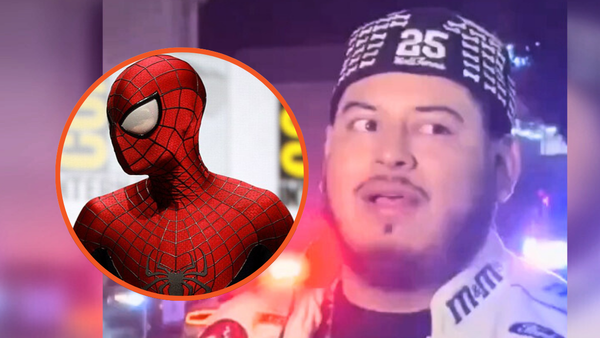
It’s easy to forget, in this modern world of AI and deep fakes; personalised algorithms and Chat GPT and access to everything, everywhere, all at once, not just how revolutionary Gorillaz were when they first emerged back in 1998, but the sheer scale of imagination it took to create the world’s first fully operational, multi-dimensional virtual band.
Dreamt up by Damon Albarn (then, already railing against Blur’s Britpop peak and taking the group in less commercially technicolour directions) and his illustrator flatmate Jamie Hewlett, Gorillaz were a feat of pure, boundless creativity. Unless you count kiddy-centric cartoon creations like Alvin and the Chipmunks, nothing like them had ever come before. Its four varyingly human-to-primate ‘members’ - 2-D, Murdoch Niccals, Noodle and Russel Hobbs - had full personalities and back stories. Their imagined HQ, Kong Studios, gave them a world in which to roam whilst cleverly bridging the gap between fiction and fact. The records that would turn Gorillaz’ human counterparts into Glastonbury headliners and global phenomena weren’t physically made at Kong, but they were very real, and – obviously – very, very good.
It’s a timely reminder, as Gorillaz celebrate their 25th anniversary, of this eye-popping ingenuity that shines through every intricately thought-out detail of House of Kong: less an exhibition, rather a fully immersive dunk into the monkey musicians’ radical world. A sensory takeover of sights, sounds and smells (yes, smells), it plucks you from the £8 plastic pints of Hackney Wick, sends you through the doors of their purpose-built industrial bunker, and spits you out into a totally different universe.

Brought to life by SWEAR, the studio of artist Stephen Gallagher – co-founder of Glastonbury’s South East Corner of rampant creativity and hedonism Block9. That pairing should give you the sense of both the scale (world-building, insanely detailed) and the vibe (playful, slightly chaotic) going on here. We’ve been sworn to secrecy on a lot of the exact details, but rest assured: the surprises are gleeful and exactly the sort of fun you’d hope for when teams like this collide.
Entering in groups past a towering statue of Pazuzu, a sticker-covered, Flying V-wielding demon god and frequent character in the Gorillaz universe, you’re given headsets narrated by curator Kate Bryan and ushered down a smoke-filled corridor with the phrase ‘REJECT FALSE ICONS’ emblazoned at the end. One of our cohort is given a package to be taken to “lost property”. No further details are explained.
The first room is almost surprising in its traditionalism. Introducing the initial conception of Gorillaz’ visual identity via early sketches by Hewlett of test characters that didn’t make the cut, plus the slow fleshing out of the final four’s distinct visual language, it is largely what you’d expect from a retrospective. Split into four sections - Miscreation, The Final Line-Up, World Building and Animation - it shows the sheer level of specificity it takes to conjure up an environment that feels so full of personality and so real. Whole sheets of drawings are dedicated to trinkets that might lay around a particular room, incidental ephemera and items that could live in a character’s pocket. Proper Gorillaz nerds, meanwhile, will enjoy the speculative storyboard for an unmade video of Plastic Beach track, Rhinestone Eyes.

And then… something happens. Like we’ve said, we can’t tell you exactly what, but suffice to say it’s where any notions of a standard gallery visit exit the room as you enter something entirely different. You could compare it to Secret Cinema, or Punchdrunk, or - yes - Glastonbury’s wilder environs, but in the truest homage to Gorillaz’ story, House of Kong has created an experience that feels entirely its own. It’s in the clever blurring of the boundaries of fantasy and reality; tangible things (magazine covers, press shots) are lined up next to surely - probably? - purpose-built items from the virtual band’s trajectory that are presented like historical artefacts. You never really know what was part of the original process, what’s been made just now, where one starts and the other ends…
Though the emphasis throughout is definitely on Hewlett’s side of the partnership, there is the intrinsic sense that one could not exist without the other. As Bryan’s voice narrates at the beginning: “Gorillaz didn’t arrive, they were built layer by layer”. Early on, you’re reminded that a then-30-year-old Albarn and Hewlett made this whole thing from nothing, probably a bit stoned, bouncing ideas around their Westbourne Grove flat. As the rest of the walk-through unfolds, ending as we’re turfed back out into the gift shop with the glowing pink original model of Plastic Beach - essentially Thunderbirds’ Tracy Island on mushrooms - to greet us, the feeling is of having been whacked around the head with unfettered possibility.
If you’re already a hardened Gorillaz fan, you’ll love House of Kong. If you know absolutely nothing about the band or couldn’t give a toss about the music, you’ll likely still be impressed. If you’ve ever had a shred of inclination to make something, or test your creative mettle, you’d be hard-pressed to find a more inspiring place. 25 years ago, Albarn and Hewlett dreamt up a project like no other. A quarter of a century on, they’re still legions ahead of the pack.
Open to September 3; houseofkong.gorillaz.com







